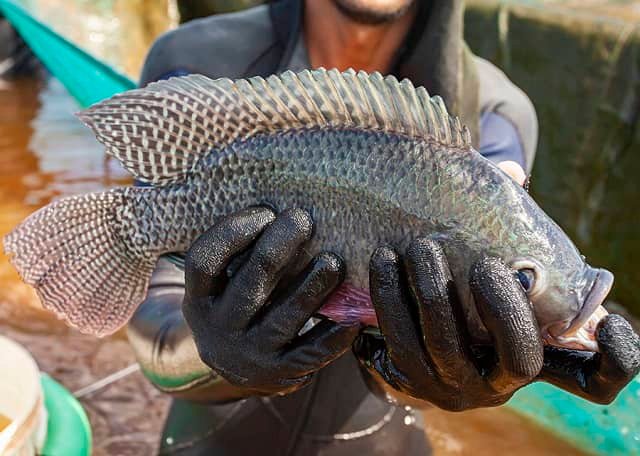
Nile tilapia (Oreochromis niloticus) is one of the leading aquaculture species globally, prized for its adaptability, rapid growth, and delicious white meat.
Its versatility, adaptability, and rapid reproductive potential have made it a cornerstone of aquaculture, particularly in Asia, the Americas, and Africa. But what truly unleashes the full potential of tilapia farming? The answer lies with the breeders, responsible for producing the next generation.
However, maintaining this success depends on ensuring healthy and productive breeders. And the secret weapon to unlock their full reproductive potential? Precision-crafted nutrition.
A scientific review conducted by researchers from the Africa Center of Excellence for Water Management at Addis Ababa University and the Department of Biology at the University of Gondar examines literature reports on the implications of Nile tilapia (Oreochromis niloticus) breeder nutrition on parameters including maturation, fecundity, fertilization, embryonic development, larval quality, and survival rate.
The study delves into the crucial role of breeder nutrition in Nile tilapia aquaculture, highlighting its impact on reproductive efficiency and sustainable practices.
Importance of Nile tilapia breeder nutrition
While Nile tilapia are prolific breeders, ensuring consistently high-quality offspring requires more than simply letting nature take its course. The key lies in providing breeders with a meticulously crafted diet. Studies have repeatedly shown how nutrient quality directly affects the health, fertility, and offspring quality of these crucial fish.
- Healthy breeders = Healthy offspring: Providing a balanced diet to breeder fish directly affects the quality and quantity of their eggs and sperm, resulting in healthier and robust fry.
- Optimizing reproductive performance: Adequate nutrients influence key aspects such as egg production, fertilization success, and larval survival, ultimately increasing overall farm productivity.
- Sustainable future for tilapia farming: By focusing on breeder nutrition, we can ensure efficient and responsible tilapia production, meeting the growing global demand for this versatile fish.
Challenges and opportunities in Nile tilapia breeder nutrition
Despite its undeniable importance, research on breeder nutrition, particularly of Nile tilapia, has lagged. This is due to factors such as limited facilities to maintain large breeder groups and the high cost of prolonged feeding trials.
- Limited research: Despite its importance, understanding the specific nutritional requirements of Nile tilapia breeders remains limited due to logistical and cost limitations.
- Varied needs: Dietary needs may differ based on factors such as age, sex, water quality, and breeding objectives, requiring personalized approaches.
Dive deeper: Impact of diet at every stage
This article delves into scientific research on Nile tilapia breeder nutrition, examining its influence on various crucial parameters:
- Maturation: A well-balanced diet boosts the development of healthy gonads, leading to faster maturation and more fertile breeders.
- Fecundity: Imagine a plethora of eggs! Proper nutrients increase egg production, ensuring a larger and healthier next generation.
- Fertilization: Sperm quality and quantity are crucial for successful fertilization. A balanced diet acts as a fertility booster, increasing sperm count and motility.
- Embryo development: A nutritious diet provides the building blocks for strong and healthy embryos, leading to higher hatching rates.
- Larval quality: From tiny fry to thriving juveniles, proper nutrition ensures robust larvae with higher survival chances.
- Survival rate: Witness your fish thrive! A balanced diet translates to better survival rates, minimizing losses and maximizing your farm’s production.
Closing the gap
The review aims to close this gap by compiling and organizing existing information on Nile tilapia breeder nutrition and its impact on reproductive efficiency. By consolidating knowledge gained from previous studies, we hope to provide valuable insights to optimize tilapia farming practices.
Unlocking the full potential of breeder nutrition requires a nuanced approach. This review delves into the science behind:
- Essential macronutrients and micronutrients: Proteins, lipids, carbohydrates, vitamins, and minerals – all play their role in a balanced diet. We explore optimal ratios for maximum performance.
- Functional additives: Prebiotics, enzymes, hormones, and even probiotics – these special ingredients can further enhance reproduction and offspring quality.
- Magic of proteins and lipids: The study delves into the potent duo of proteins and lipids. Their influence on vitellogenesis (yolk formation), ovarian maturation, fecundity, egg hatching, larval quality, and even fry survival is undeniable. Finding the optimal balance between these two nutrients is crucial to maximizing offspring quality and quantity.
- Feeding regimen delicacy: Studies show that the feeding regimen, including frequency and timing, can significantly affect reproductive performance. Optimizing these factors ensures efficient nutrient utilization and optimal egg development.
Conclusion
This review provides you with the scientific knowledge to optimize the nutrition of your Nile tilapia breeders. By understanding the intricate relationship between diet and reproductive performance, you can unlock the full potential of your fish farm, ensuring sustainability, profitability, and a thriving fish population.
This exploration serves as a springboard for future research. Understanding species-specific requirements, age-related differences, and environmental factors is crucial for fine-tuning nutritional strategies.
By prioritizing the nutritional needs of Nile tilapia breeders, aquaculture can unlock its potential for sustainable and productive fish farming. Investing in research, knowledge sharing, and personalized diets is key to unlocking a better future for this vital source of protein.
It is important to note that while nutrition plays a significant role in tilapia reproduction, other factors such as the farming system, implementing good practices for fry production, and genetic selection are also important.
Reference (open access)
Woldeab, F., & Geremew, A. Broodstock Nutrition in Nile tilapia and its implications on Reproductive Efficiency. Frontiers in Aquaculture, 3, 1281640.

